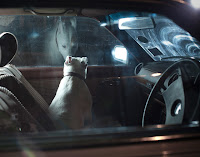----
Favorite Quotes :
"Memory is like a string. We cut parts [or segments] out and then knot it back together."
"Writing is a form of magic."
**"What came first, orange or orange? Why orange, of course."**
"Magic is about the utopian way of looking at the world."
**One of the things that I liked about Singh's lecture/performance was the seemingly small connections between objects. I like the questions he posed and the thought process that developed from his images and speech about the interconnection between them.
----
3 Words : Magical Interconnecting Narratives
----
I learned about using a strong narrative that is carried throughout one work. I really enjoyed the face that he create a narrative that speaks throughout his various installations on the same subject. The thought process and development of his work was interesting and I thought his performance was more interesting than the images of the collages in white ikea frames.
----
What influenced you to create an Gothic narrative based on the founder of Adidas?
The desire to build a body of work around Adidas came out of my own intensely personal relationship to the brand. They are the only shoes that I wear - absolutely no others.
In Assembly Instructions, how did you come to this way of making the film piece, like x-rays on a light box?
The images are being projected using an overhead projector. The ‘slides’ are photocopied transparencies of the collages placed on the glass. I wanted a way to manipulate the images in an analogue and tactile way that was direct, and that like the voice, stumbles and errs.
----
The project that I enjoyed the most is Free : The School for Objects Criticized.
Description : A conversation spins out on vertiginous loops and wild tangents, loosely centered on a debate of the merits of The School for Objects. The School for Objects Criticized inverts the roles of artwork and spectator by letting sculptures speculate on the world of humans. Their bombastic utterances on art cast doubt on our own discussions of art and culture, on the contradictory and ill-considered ideological criteria we often use to judge the worth of art.
 The narrative of these objects was humorous and interesting toughing on subjects that a common to everyday conversations. The imaginative conversation between objects brings a new spin to conversations and current topics by people. The voices were entertaining and fitting for each object. I really enjoy the overall narratives that Singh writes for all of his installations and works.
The narrative of these objects was humorous and interesting toughing on subjects that a common to everyday conversations. The imaginative conversation between objects brings a new spin to conversations and current topics by people. The voices were entertaining and fitting for each object. I really enjoy the overall narratives that Singh writes for all of his installations and works.


















































